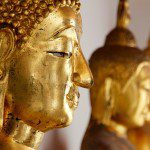When I was 15 or 16 I went to the hospital for a physical. The doctor looked me over – basically healthy, okay. Then he looked at my feet, grimaced a bit, and proclaimed, “you’ll never be a runner with these.”
I took it as gospel truth at the time, but soon after began at least trying to run with my older sister who was a competitive cross-country runner in her high school days. And run I did. My very low arches (not quite flat feet) have caused me some difficulty here and there, but through adjustments in form and flow, I’ve managed to run about half a dozen half-marathons and one full one. Time to start thinking about that second full one…
For me, and I imagine for most runners, running has always been about more than just running. There is a sense of possibility that comes with pushing oneself further than one has gone before, feeling the burning of the legs and lungs, the pain, the desire to just stop, and then going on anyway, knowing that you can. That sort of self-overcoming translates into other aspects of life, where we can feel stuck or limited or unappreciated. The Buddha said that life is dukkha – unsatisfactory or suffering – but he also said there is a way out of dukkha, but it takes some work. The process of working one’s body-mind (as the two are never separate) in ever longer and more challenging runs builds the habit of overcoming limitations.
As a chubby shy kid – not just shy but developing social anxiety disorder in my late teens – I had my fair share of limitations to overcome.
A second aspect of running that I have found fascinating is how it can tie directly into Buddhist or other Asian philosophies and practices. It is, after all, a very weird bit of sport. Just running? No balls? No teams? No Pokémon? What does it do for us in terms of helping to recognize that mind-body connection?
In 2007 I was turned on to “Chi Running,” a method – and book – aimed at allowing the body’s natural flow of energy to propel the runner forward, almost effortlessly. I soon after found “Born to Run,” which further explored the history and physiology of running – again suggesting a sort of effortless flowing method of running. So if we’re “born to run” as a species and have the capacity to let our own bodily energy (chi / qi) propel us, perhaps even this chubby, nearly flat-footed guy could get serious about running.
And serious I became.
Fast-forwarding to today, I’m happy (though still shy) to note here that I’ve been interviewed and featured on ON BEING’s new podcast, Creating Our Own Lives (COOL), alongside Olympic gold medalist Billy Mills and a host of truly, truly amazing men and women, all runners and incredible human beings. Listen, for example, to Christina Torres:
People from high school now tell me, like, I never thought you would have become a runner of any kind. I always used to tell people, “I’m not a runner, my body could never do that.” And once I did it, it was this feeling of, like, what else have I been lying to myself about? What else have I been hiding from because I was scared? Yeah, for me, it was this sense of limitlessness, like all of a sudden there were no expectations I could put on myself, because I felt like I could expect anything.
Or Ashley Hicks, founder of Black Girls RUN!:
When I run, the one thing that I like to do is I don’t run with music, headphones, anything. I call myself a true minimalist runner. Literally it’s just me and my running clothes. I like to go out and I start out slow and then I will pick up my pace after that. But for me, it’s just the idea of allowing myself to kind of settle into the run. Settle in and to feel the road beneath your feet. Settle in and really acknowledge your surroundings. I think a lot of times we go through life and we’re not really present in the moment, so when I run, it’s this idea of really being present and acknowledging where I am and what I’m doing and the purpose.
Or any of the other remarkable individuals interviewed for the series.
This is one of those moments when I look at my life with a bit of wonder and gratitude. I have been a bit lazy with my running for the last couple years, but this week I managed two longish runs of over 30 minutes and tonight I attempted and mostly completed a long uphill mountain run – about 35 minutes up and 25 minutes down. I keep thinking I would like to add more to what I have written and what I mentioned in the interview, but I think it is almost one of those things that has to be taught in person. Certainly, we can all think about and practice “leveling the pelvis” out when running, especially if we are a meditator who has done this on a cushion. Yet that process is done in the movement of running, so there are a number of sensations, from the legs on up to and through the lower back, that need to be watched. Put briefly, those sensations should be of a new looseness; the pelvis flowing effortlessly left and right. And that flow should be felt, again, down the legs and up the back.
The “chi / qi” aspect of it is in reducing blockages of that flow, which are created when we tense up certain muscles that we really don’t need to use in running. The most common example of this is in the very upright form of running we see many people engaging in today. The correct posture uses slight leaning forward; such that the body remains straight but the tilt of the body creates momentum and the legs are used to simply catch each fall. Again the similarity of meditative posture is apt, where a good posture sets the pelvis at just the right tilt that the spine rises up effortlessly, a long neck bringing the chin slightly tucked in. The same principles translate into the running posture, only now we’re standing and letting our legs catch us as we tilt forward and fall, fall, fall again.
That “fall, fall…” process is what, ideally, keeps us from using too much energy when running. We’re not “push, push, pushing” ourselves along as runners with poor form do. We’re just catching ourselves, again and again.
This is where mindfulness comes in, of one’s body and one’s surroundings – but that will have to be saved for another post. For now, just let me revel in a bit of gratitude to Lily Percy and the folks at ON BEING for including me in this series, and encourage you to find your way into running, mindfully and with good energy flow, in the near future.












